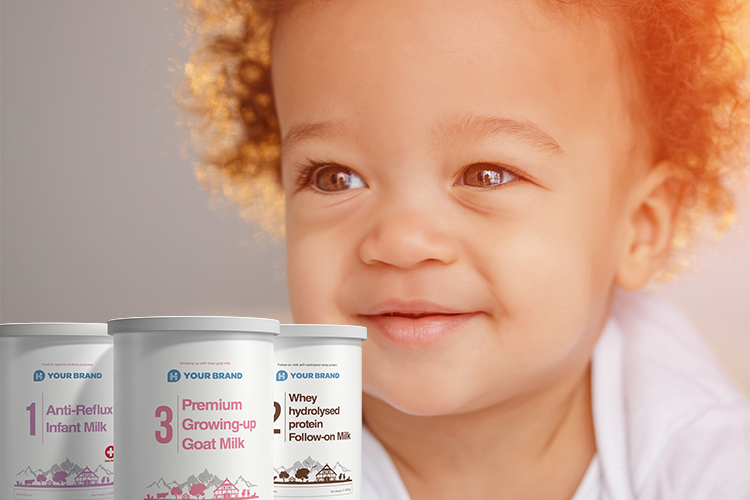
Emma and Noah were born in the same hospital on the same day. Everything has started well and their parents are delighted that they are in such good health. To maintain this ideal beginning, the newborn child has to develop a strong immune system and healthy microbiota as soon as possible. This is the only way to protect Emma and Noah’s little systems from all kinds of foreign bodies and pathogens. It’s an unusual experience for both babies as they have not had any contact with pathogenic bacteria or viruses in the womb. The placenta only supplies them with the first bacterial strains (1) that they need to build up and develop the microbiota and the immune system.
The rapid development of healthy microbiota – essential to life
How do Emma and Noah acquire the ideal amount of benign bacterial strains and a healthy microbiota as quickly as possible? Research has shown (2) that the composition of bacteria populations and so microbiota is related, among other things, to our diet and to environmental conditions.
Emma was able to acquire new bacterial strains with positive properties relatively quickly. The little girl wasted little time in leaving the womb via the birth canal and so picked up around 900 “free” bacteria types (3). They were passed from mother to daughter in the birth canal, protecting the newborn child before she even came into contact with external germs.
Noah had a harder time of it. Instead of squeezing through the birth canal, he was born by Caesarean section. So his first bacteria came from skin contact with the various people coming and going on the maternity ward rather than straight from his mother.
The body and bacteria form a sensitive eco-system together. The human system provides both space to live and nutrition.
Compared to the vaginal flora, the skin flora is much more exposed to the external environment. It might therefore contain bacteria that is not conducive to the development of healthy microbiota and to a well-functioning immune system. Noah will take many more months to develop the same microbiota compared to children delivered naturally (3, 4). He will reach the age of seven before it is no longer detectable whether he was born naturally or by Caesarean section.
The right combination of good bacteria is what makes the difference
The first maternal bacteria mix is normally all the newborn needs to develop a healthy microbiota. It will subsequently include around 400 different species of bacteria (5). However breast milk also supplies infants with bacteria and nutrients that encourage the growth of bacterial strains in a more specific, intestine- friendly way. This is just one of the many reasons why breast feeding is generally the healthiest way to feed an infant.
The lactobacilli and bifidobacteria that produce lactic acid make up half the bacteria present in the colon. They provide the acidic environment that is essential for our health. Lactic acid forms a natural barrier that is virtually impregnable for most pathogens such as Salmonella or putrefactive or coliform bacteria. And if they do get past this barrier they are then faced with a huge array of benign bacteria that have populated our intestinal wall. The wall is so densely populated, in fact, that the pathogenic invaders have little room to spread.
GOS – an important prebiotic for a healthy microbiota
The development or population of the colon with “good” intestinal bacteria is relatively complex. The body and bacteria form a sensitive eco-system together. The human system provides both space to live and nutrition. The nutrition of intestinal bacteria consists of fibre and specific carbohydrates in particular. However the lactobacilli and bifidobacteria so important for developing microbiota are extremely choosey. They will only take nourishment from carbohydrates. As a waste product of their digestion they excrete short-chain fatty acids, gases and strong lactic acids. The lactic acids arrest the growth of unwanted bacteria, which is an extremely desirable side effect. For instance, galactooligosaccharides, also known under the technical term GOS, belong to the carbohydrate family. GOS are indigestible oligosaccharides and are also prebiotics. They occur naturally in breast milk and are also present in extremely small quantities in cow’s milk. This is an additional problem for Noah, the Caesarean section baby, who rejected breast milk after four weeks and has taken infant formula since then.
Infant formula enriched with GOS
However, Noah’s parents have no great cause for concern provided that they give their little one infant and follow on formula enriched with GOS, such as the milk produced by HOCHDORF. We have been aware of the importance of GOS in developing and maintaining healthy microbiota for some time. Breast milk contains over 130 different oligosaccharides, but most belong, like the GOS, to the prebiotics group. Our infant formula contains easily digestible galactooligosaccharides, which are said to cause very little gas in babies.
One study, for instance, showed minimal difference between formula and breast-fed children with regard to bifidobacteria, lactobacilli and other parameters (6). There are studies that clearly show that GOS-enriched infant and follow on formula actually stimulate both bifidobacteria and lactobacilli (6, 7, 8) and so also ensure a balanced microbiota (7, 8, 9, 10, 11).
So it will be interesting to see how Emma and Noah progress in the coming months. Find out more in the next edition of HOCHDORF Inside.
Further information
- Short article "Good and bad bacteria"
- Overview "Interesting facts about our bacteria zoo"
- Overview "The difference between prebiotics and probiotics"
- Article "Carbohydrates – It's all the mix"
- Article "Prebiotics in follow-on foods, part 2"
Sources
1) Jimenez E et al. Isolation of commensal bacteria from umbilical cord blood of healthy neonates born by caesarean section. Curr Microbiol 2005; 51:270–274.
2) Enterotypes of the human gut microbiome, published in Nature. 2011 May 12; 473(7346): 174–180.
3) Bik EM. Composition and function of the human-associated microbiota. Nutrition Reviews® Vol. 67 (Suppl. 2): 164–171.
4) Palmer C, Bik EM et al. (2007) Development of the human infant intestinal microbiota. PLoS Biol 5(7): e177; doi:10.1371/ journal.pbio. 0050177.
5) www.spektrum.de/lexikon/biologie/darmflora/ 16824 Copyright 1999 Spektrum Akademischer Verlag, Heidelberg.
6) Ito M et al. Effect of administration of GOS on the human faecal microflora, stool weight and abdominal sensation Microb. Ecol. Health Dis. 1990.
7) Ben XM et al. Supplementation of milk formula with GOS improves intestinal micro-flora and fermantation in term infants. Chin. Med. J. 2004.
8) Napoli JE et al. Bifidogenic effects of feeding infant formula containing GOS in healthy formula-fed infants. Asia Pac. J. Clin. Nutri. 2003.
9) Sierra C et al. Prebiotic effect during the first year of life in healthy infants fed formula containing GOS as the only prebiotic: a multicentre, randomised, double-blind and placebo-controlled trial. Eur J Nutr (2015) 54:89–99.
10) Bongers A. et al. Prebiotics and the bioavailability of minerals and trade elements. Food Reviews international 2003.
11) Schoterman HC. GOS properties and health aspects. Advanced Dietary Fibre Technology/L.Blackwell Science 2001.










Leave a comment